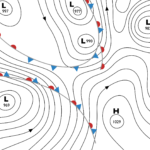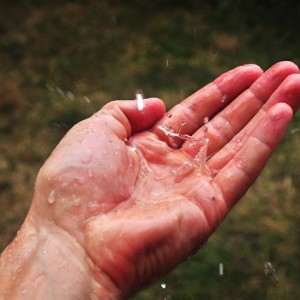
I was an environmental consultant for 45 years. Along the way, I studied the history of how environmental management evolved in the United States. From understanding that history, one can appreciate:
- how far we've come; and
- how to avoid new trouble.
Today, the US environment is almost totally regulated. There are still flaws in our scientific understanding and technology, however, so we still have environmental problems. Budget is also a factor. But despite our remaining problems, notwithstanding climate change, things were much worse historically. For example:
- In the mid-19th Century, cholera from drinking water killed President Polk and thousands of Americans per year.
- Over 150,000 Americans died of cholera between 1830 and 1850.
- Around 1900, a city of 1 million people might expect 800 deaths per year from drinking water-borne typhoid fever.
Now with chlorination, pathogenic disease from drinking water is a thing of the past. We now have the luxury to worry about aesthetics and the penultimate problem of hazardous chemicals.
I assume you're here to learn how environmental management works today, but first it might help to understand how it evolved.
Evolution of Environmental Management
Since cave man times, environmental management advanced because of 3 things:
- We're here and it's there.
- The fouled nest syndrome.
- Improved science.
Romans built aqueducts to bring water from “there” to “here.” Medieval villages learned to channel sewage away from the town center to avoid fouling the nest. Pasteur's science eventually led to safe drinking water. And today we know so much that we know the flaws in those game changers.
In the United States, the evolution of environmental management is essentially a 20th Century story. Before that, except perhaps for places like New York, it was rare to foul our nest. New York fouled its nest early so many of today's environmental management concepts started in New York's 1890s. Some key dates for environmental evolution in the 20th Century are (approximate):
- 1900 - first air pollution studies
- 1902 - first water quality standard
- 1908 - first US drinking water chlorination
- 1925 - first mathematical model of water pollution
- 1948 - first federal Clean Water Act
- 1970 - Earth Day
- 1970s - All the modern environmental laws
- 1980s - Hazardous waste laws
I will describe this evolution to you by medium - air, water, and soil.
 Air
Air
Air pollution management evolved from concerns about dirt and dust - such as soot on our drying laundry in a backyard next to the coal boiler. By 1900 we were concerned about a few chemicals like metals from smelters, and by the 1950s we learned of smokestack acids causing smog and acid rain. Finally, we now focus on specific chemicals in air.
Two seminal events taught us that air pollution was more deadly than just soot smudging our laundry. A 1948 smog in Donora, PA killed 40 people and made half the town sick. London's “Great Smog” of 1952 killed 4,000 and made 100,000 sick. Around this time California's smog became intolerable and a CalTech professor figured out that smog was caused by photochemical reactions in the atmosphere from 3 air pollutants -organic chemicals, nitrogen oxides, and sulfur oxides. He coined the term, “smog” as a contraction of fog and smoke, although it is much more complicated than that.
Much smog was caused by automobiles, but that was not their only problem. In the 1920s, DuPont and General Motors, after discovering tetraethyl-lead's antiknock properties, snookered the US Surgeon General, amidst some vigorous scientific opposition, to allow the use of leaded gasoline throughout the country and eventually throughout the world. After years of debating lead's health effects, leaded gasoline started being phased out across the world in the 1980s, although some stalwarts like China didn't ban it until 2000.
But lead air pollution has not been just an automobile problem. Leaded paint used to be the best you could buy and now we still deal with its aftermath. Lead mining and smelting affected specific areas of the US, primarily in Missouri due to air pollution. As I will discuss later when I talk about current environmental management, lead is so important that it is 1 of only 6 nationwide air quality pollutants regulated by the EPA.
In the 1950s, the Eisenhower administration described air pollution as a “local problem.” Of course, today we know it is a global problem - we track pollution from China blowing to the US, for example - but that early view probably shaped how air quality is regulated today via very strong state participation. I'll get into that later, but here I want you to understand the scientific difficulties inherent in air regulation. They stem from the difficulty with measuring air quality. You can't control what you can't measure.
The first difficulty is the form of air pollution - particles, mists, and gases. Almost ethereal, not so easy to measure.
Also, it's not easy to understand their health effects. For example, particles by themselves can be harmful. Fine particles lodge deep in the lungs and cause disease by irritation. And sometimes those particles also contain unhealthful chemicals - lead, for example. So the particle might cause 2 health effects, one from the particle itself and one from its composition. The mists and gases are comprised of sometimes harmful chemicals and, worse, react in the air, causing smog for example, which then creates its own health impact. To manage them, these things need to be predicted, which is also not easy.
The second difficulty is the medium itself - air. Air is a very big “thing” and we are trying to measure very little things in this big thing that moves around a lot. It took decades to work out a reasonable approach to air sampling - ground level, towers, associated meteorological data, collection/averaging time, sampling station distribution, and dozens of other issues. And air has some “natural” things in it that can confound air sampling. For example, bird droppings into particle samplers probably took 10 years to work out. The moving around part is also a very big deal. Think about sampling representative air quality on a sunny, calm day versus in a hurricane.
The third difficulty is the nature of pollution emissions. There are 3 types - stationary, mobile, and fugitive emissions. Stationary sources are things like smoke stacks, and although they are the easiest to measure, there are still great difficulties like reaching up 100 ft to the outlet and understanding where the emitted plume reaches ground level so it can be measured. Mobile sources are more difficult because they are a “moving target.” Sampling strategies for such emissions are usually not aimed at moving with these mobile sources but rather at sampling along highways to capture average conditions. Fugitive emissions include things like windblown dust, factory materials loading operations, and stuff that boils or blows out of factory processes and out building windows. But such emissions are not just from factories. They might be from your local sewage treatment plant, a construction site, or even your own backyard blowing lead in the dust from the lead paint flaking off your siding. The significance of fugitive emissions for the regulation of air quality was first realized in the 1970s and fugitive emissions remain today the most difficult air pollution issue.
So you hopefully see how complicated it is. It took a long time to grapple with air pollution. Because air pollution is so hard to measure properly, we rely on predictions using mathematical models. For given emissions models simulate transport processes to predict downwind concentrations. Rudimentary air modeling began with WWI mustard gas predictions and evolved to what is called “Gaussian Plume” modeling in the 1940s and ‘50s. The term, “Gaussian” is more commonly known as “bell-shaped” and refers to statistical environmental representations. In many cases, air models required an estimate of the emissions because even that part couldn't be measured properly. Standardized emission factors for many types of industrial sources were developed by the US Public Health Service in the 1960s. Such standardized factors continued to evolve for the next 30 years while other emissions were actually measured.
So through the 20th Century the following air pollution issues and methods evolved:
- Understanding the nature of air pollution - e.g., particles, lead, etc.
- Developing measurement methods - both emissions and ambient air quality
- Perfecting models for prediction of downwind air pollution impacts.
With these technical developments, the US was ready for air quality management, which I will describe in a moment.
Learn more about air related topics:
- Ambient Air Quality and Environmental Health
- Indoor Air Quality and Environmental Health
- What is an Air Pollution Analyst?
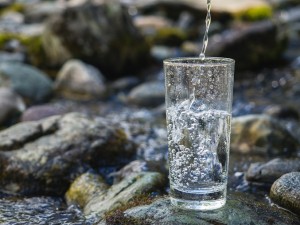 Water and Drinking Water
Water and Drinking Water
With drinking water quality in mind, the first half of the 20th Century debated how to control water pollution - at wastewater discharges or by allowing unfettered pollution while treating polluted water at the drinking water plant. Ultimately both have turned out to be needed.
The early focus on water pollution was on what we now call “conventional parameters” - dissolved oxygen, particulates, bacteria, acidity, and nutrients. When sewage is dumped in water, natural microbes in the water “eat” the sewage and deplete the water's oxygen supply in the process. This is called “natural purification.” Its process is the basis of most sewage treatment plants. Surface water continuously replenishes its oxygen by absorbing it from the overlying atmosphere. This is called “reaeration.” When reaeration can't keep up with degradation, the water becomes putrid, fish die, and nasty bacteria that emit stinky things like sulfur take over. That's called water pollution. Other forms of water pollution come from too many nutrients, like phosphorus and nitrogen. Excess nutrients cause algae blooms, which die and degrade, thus consuming the water's oxygen. That's called “eutrophication.” Another form of pollution comes from particles. Too much particulate matter makes water cloudy, called “turbidity” and ugly. Another form of pollution is from pathogenic bacteria that cause diseases. We measure the potential for that by sampling for “fecal coliforms,” which are bacteria that live in warm-blooded intestines. Water with fecal coliforms is suspected of also being disease-bearing. And finally, there is pollution from specific chemicals. I'll come back to that in a moment.
The balance of oxygen in water from natural purification of wastes and reaeration was first characterized by the US Public Health Service in 1925. It was called the Streeter-Phelps model after the two scientists that did the math. The Streeter-Phelps model and its since-evolving complexities remain the fundamental principal of sewage treatment and sewage-based pollution control today.
With the invention of drinking water chlorination in the early 20th Century, the heat was off for most pathogenic water pollution, but our fouled nest syndrome became inescapable around mid-century as population and industrialization intensified. Ohio's Cuyahoga River fires of 1952 and 1969 highlighted our fouled nest and served to motivate the US to tackle water pollution. The first step was to understand its extent.
We learned the extent of water pollution with nationwide stream studies in the 1950s and 1960s. For the first time, state and federal agencies sampled rivers and lakes across the nation. The problem was that we were not sure how or what to measure. We ended up measuring pretty rudimentary things from today's perspective but necessary and fundamental for the issues of the time. Walk before trying to fly. Those water quality measures were the conventional parameters. An important catchall parameter for waste degradability was called BOD for “Biochemical Oxygen Demand,” which was probably the most measured water quality parameter for decades before we became concerned about specific chemicals. We also had to learn how to sample, for example what depth to sample a stream. Luckily the sampling challenges were less onerous than for air pollution. We worked out most of this by the end of the 1960s and we had a nationwide compilation of “stream studies” and a new EPA database of nationwide water pollution data called STORET.
Congress had toyed with water pollution regulation since before WW2. It was ineffective for decades because the feds couldn't decide if states or the federal government should have control. This was the still tender “state's rights” issue left over from the Civil War. That changed with the 1972 Clean Water Act, when the feds clamped down and took over. The Clean Water Act made it illegal to discharge any wastewater without a permit and set a 12-year timetable for building and upgrading sewage treatment plants across the nation. The Clean Water Act remains today the backbone of US water pollution regulation and I will discuss its details in a moment.
Another important element of the 1972 Clean Water Act was EPA's many studies of water pollution. The agency funded hundreds of studies to characterize the nature of pollution from every kind of industry, to foster improved treatment technologies, and to study the nature of water pollution in many ways. In 1973 I worked on a project sponsored by Congress' National Commission On Water Quality to predict the impact of the 1972 Clean Water Act on the Charles River and Boston Harbor. The answer was the impact would be minimal because the law did not deal effectively with non-point source pollution, such as storm runoff. Non-point source pollution is better understood today to be a very significant pollution factor, and EPA is currently making good progress dealing with it, but it is a very difficult problem.
There are many other facets to water pollution besides just sewage and eutrophication for which decades of study have resulted in better understanding and control. For example:
- Acid rain - power plants in the Midwest emit sulfur oxides which rain sulfuric acid into the eastern streams. Acidification upsets ecologies and dissolves extra minerals. Since the 1970s Hubbard Brook studies in New Hampshire, it took about 10 years to understand acid rain and start controlling coal-fired power plants. The problem appears to be improving.
- Acid mine drainage - streams in some parts of the country are red and acidic enough to corrode metal. It turns out that bacteria make it. They metabolize the sulfur in pyrite, a mineral often co-mined with coal or iron, and release sulfuric acid. The “red” comes from the acid dissolving iron.
- Mercury - Mercury bioaccumulates in fish and thus offers health threats. Many fish contain about 0.5 mg/kg of mercury; the FDA level believed to be safe is 1 mg/kg, Canada says 0.5. The mercury is in a form called “methyl mercury” which is made by bacteria converting elemental mercury, which of itself is not very toxic.
- Priority Pollutants - Because EPA did not enforce the Clean Water Act's toxic chemicals section soon enough the Natural Resources Defense Council sued them in 1976 and 129 “Priority Pollutants” were identified for control in a settlement. The presence of these or other specific chemicals in water is very site specific and their fate is often hard to predict. The potential risks they pose are from ingestion during recreation, from eating fish that might bioaccumulate them, or if the water is a drinking supply.
Safe drinking water is how I will end this part on water pollution. For most of the 20th Century we believed safe drinking water was clear water without pathogens. As I mentioned earlier, chlorination essentially solved the pathogen problem and once our nest go more fouled we used drinking water treatment plants to make turbid water clear. But even chlorination turned out to have problems. In the 1970s we discovered that toxic chemicals like chloroform could be formed from chlorination. Trouble in paradise. Today, we monitor public drinking water for chlorination byproducts and dozens of other potentially toxic chemicals. I'll explain more about that, later.
Learn more about water related topics:
- Groundwater Introduction & Career Avenues
- What is a Wastewater Treatment Operator?
- What is a Groundwater Protection Specialist?
- What is a Watershed Science Technician?
- What is a Water Resource Engineer?
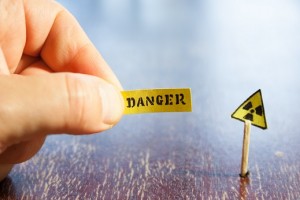 Hazardous Waste
Hazardous Waste
Today's hazardous waste issues prove there is no free lunch:
- Pollution control creates residuals, like sludge, that may contain toxic chemicals so that the residuals themselves need management;
- Many of the products we love involve nasty byproducts from their manufacture that must be managed; and
- For years we ignored the first two and it came back to bite us.
We didn't start to understand all this as a separate type of pollution problem until 1979 when Love Canal overflowed its toxic brew. That's not exactly true because EPA started thinking about specific chemicals in water when it made its “Priority Pollutant” list in 1976 and explicit hazardous waste management also started in 1976 with the passage of a federal law called RCRA. Still, Love Canal was the wakeup call. I worked on Love Canal and 3 related landfills for about 10 years in the 1980s. In those early times, no one understood what to do. We developed ways to study the problem and ways to deal with it for the first time ever in the 1980s. Previously, science believed that the best thing to do with anything as nasty as hazardous waste was to bury it in the ground. That recommendation was aimed at protecting water supplies, but it turned out to be unwise.
Although not totally, many of our hazardous waste issues are underground - in soils and groundwater. (Many rivers today are also considered to have hazardous waste problems in their sediments.) Groundwater provides 25% of our freshwater supply so the former belief of burying hazardous waste to protect water supplies turned out not to be true. But until the 1980s and even beyond, science did not understand how buried waste contaminated soils and migrated into groundwater. Or even how people became exposed to the chemicals contaminating soils. But let me back up and define better why hazardous waste is an issue.
EPA defines a waste as hazardous if it has at least 1 of 4 characteristics - flammable, ignitable, corrosive, or toxic- or if the agency has listed it as hazardous because it knows something about how it behaves. The last hazardous characteristic, “toxic,” is somewhat vague and subject to misunderstanding.
Hazardous wastes are usually either liquid or solid, although some form gases. Liquid hazardous wastes are referred to as NAPL, non-aqueous phase liquid, an acronym my negotiating team coined in the Love Canal days. There is floating, or “light” NAPL, called LNAPL and sinking or “dense” NAPL, called DNAPL. LNAPL, like gasoline, floats on the water table and can vaporize upward and spread long distances. DNAPL, like tar, can sink deep into the ground, slowly dissolve its constituents into groundwater, and be impossible to remove. Solid hazardous waste constituents slowly dissolve into groundwater, a process we call “leaching.” So all 3 - LNAPL, DNAPL, and solid waste - contaminate groundwater. They also contaminate soil. NAPLs soak into the pores, called absorption (with a b), and their constituents chemically bind onto soil surfaces, called “adsorption” (with a d). Solid hazardous wastes leach constituents which then adsorb to soils. And of course their unadulterated forms are hazardous also.
A typical “hazardous waste site” has one or more core areas of wastes, which we call “sources” and a larger area(s) where the NAPL has migrated and the chemicals have leached onto soils and into flowing groundwater. Contaminated groundwater might migrate miles away and be hundreds of feet deep, depending on the groundwater transport conditions. Sometimes the depth of contamination is limited by what we call a “confining layer.” Confining layers are subsurface layers of clay, silt, or peat that tend to limit the flow of chemicals or water through them. In the hazardous waste business, we like confining layers. However, “limit” in this case might mean slowing down transport by centuries, but not stopping it altogether.
So, in a nutshell, a hazardous waste site consists of source areas and impact areas. We study them to define the source areas (chemical content and dimensions), the transport of chemicals out of the sources, and the nature of the impact areas (again, chemical content and dimensions). We also study them to determine if their conditions are stable or getting worse. I'll describe more when I discuss the current framework. For now, remember we did not know how to do this until the 1980s when a lot of damage was already done.
The second consideration about hazardous waste sites is what to do about them. When the issue first arose in the 1980s, we hoped we could destroy the waste and restore the sites to pristine. We tried incineration, electrocuting the soil, digging it all up (but where do you put it next?), and dozens of “innovative” technologies promising to be better mouse traps. Most of these things didn't work well because they were either ill-conceived or couldn't reach all the contamination. We quickly learned it was expensive and took a long time. The average Superfund site takes 20 years to clean up and one type of tarry hazardous waste site costs an average of $6 Million to clean up. The Hudson River Superfund site will probably cost over $2 Billion before it is finally cleaned up. The Passaic River will cost over $3 Billion.
Now that the dust has settled a little, 35 years after Superfund was passed, addressing hazardous waste sites might be described simplistically as:
- Source and impact control
- Restoration vs management
The key to both these concepts is that sometimes you can clean it up, but other times the best you can do is make sure it does no further harm. I will talk more about this and the common technologies in a moment.
Today's Environmental Management
Today in the United States, we have a law and regulations for every aspect of environmental contamination:
- The Clean Air Act regulates the air we breathe.
- The Clean Water Act regulates our surface waters and all discharges to them.
- The Safe Drinking Water Act regulates our drinking water.
- RCRA and CERCLA (Resources Conservation and Recovery Act and Comprehensive Environmental Response Compensation and Liability Act) regulate disposal and cleanup of hazardous wastes.
- OSHA (Occupational Safety and Health Act) regulates safety, chemical and physical, in the workplace.
- Nuclear safety is managed by the Nuclear Regulatory Commission established by the Energy Reorganization Act (1974) following the Atomic Energy Act of 1954.
And there are others, such as TSCA the Toxic Substances Control Act, which sounds good but doesn't seem to do anything, FIFRA (Federal Insecticide Fungicide and Rodentcide Act), Food and Drug Administration rules, and Consumer Product Safety Council rules, just to name a few. As a result of these laws, there are hundreds of thousands of regulations, including public “Right-To-Know” regulations. On the topic of your right to know, some laws, like our hazardous waste law, actually require reporting and community safety planning.
The federal honcho for all this is the US Environmental Protection Agency (“EPA”), headquartered in Washington with 10 Regional Offices throughout the country. In addition, each state has environmental agencies, which sometimes work independently to implement state laws and sometimes work with EPA to implement federal laws. There are also many other federal agencies that are responsible for specific elements of environmental management. To name a few, there is:
- The Nuclear Regulatory Commission (NRC), as noted above.
- The Centers for Disease Control (CDC) and its Agency for Toxic Disease Registry (ATSDR)
- Many cabinet departments, such as Agriculture, Commerce, Interior, and Justice
- The President's Council on Environmental Quality (CEQ)
- NASA
and many more. The jurisdictions, extent, and sometimes overlapping or even conflicting environmental agencies and regulations are overwhelming. Most companies have departments just to keep up with compliance. Some think our framework is economically destructive and interferes with progress. That's probably true in some cases, but we must ask whether the framework do more good than harm? I personally have seen conflicts, such as with the regulation of a group of chemicals called PCBs, which is covered by at least 3 laws and through different departments in the same agency. So how do we deal with it all?
In my field of environmental engineering, no one tries to deal with all of it. We specialize in one or a few regulatory areas and learn those specific federal rules and pertinent state variations. We may be scientifically broad, but most often we are quite narrow in a regulatory sense. Even EPA is like this. One of my most effective tools negotiating with agencies was to explain their own policies to them.
Modern environmental management in the United States boils down to 2 objectives:
- prevention; and
- clean-up
The former is about regulatory compliance while the latter is about fixing mistakes. Mistakes come in 2 forms - historical events before we knew better and more recent mishaps. My career focused mostly on fixing the mistakes, although in my early days I worked prevention in the form of waste treatment technologies. Today, the Clean Water Act, the Clean Air Act, and the Safe Drinking Water Act focus mainly on prevention, while CERCLA, also known as Superfund, focuses on cleanup. RCRA does both - prevention via rules for the current handling of hazardous waste, and clean-up of problems from former hazardous waste handling at still open facilities.
Keeping the prevention vs cleanup concepts in mind, let's go over the basics.
Clean Water Act
The Clean Water Act of 1972 regulates surface water quality. It establishes water quality standards for all surface waters and maintains those standards by regulating all wastewater discharges by a permit program. According to the Clean Water Act it is illegal to discharge anything from a pipe in the United States without a permit. In its early days, the Clean Water Act also implemented huge programs to get wastewater treatment in place and upgraded throughout the nation, municipal and industrial, in many cases for the first time. In a nutshell, that's it, but there are many technical complexities associated with the Clean Water Act, such as:
- Construction Grants Program - the federal government subsidizes the construction and upgrading of municipal sewage treatment plants. This program was huge in those early days of the law.
- NPDES (National Pollution Discharge Elimination System) - this is EPA's wastewater permit system, sometimes run by the feds and sometimes delegated to states. Permit limits are established by considering the receiving stream's water quality standards and its ability to assimilate the discharge, through calculations called “waste load allocation.” Remember the Streeter-Phelps model - it is the basis for municipal sewage waste load allocation calculations.
- Non-point source pollution - For 30 years, NPDES focused on what we call “point source” pollution - municipal or industrial wastewater through pipes. A much more difficult problem, and now recognized to be a very significant influence on water quality, is surface runoff, called “non-point source” pollution. About 2/3 of precipitation runs off into streams or lakes collecting all kinds of nasty stuff as it runs along the ground and into storm drains or sewers designed to carry both sewage and runoff, called “combined sewers.” The technical challenge with non-point source pollution is that its quality is highly variable as is its flow. Makes treatment difficult. Starting around 1999, EPA started tackling this issue nationwide via its permit program and by requiring what we call “best management practices.” Two examples of these best management practices are the hay bales you see around construction sites and the runoff holding ponds you see in the median or on the side of highways. Once we solve this non-point source pollution problem, you will see significant improvements in surface water quality.
- Area wide management programs - focuses on coordination of waste water and water quality management beyond political boundaries. After all, most rivers don't recognize city limits.
- Spill prevention and response programs - requires each industry to have a plan for prevention, response, and reporting spills that could run off into receiving waters.
- Toxic substances - as noted earlier, EPA established the 129 chemical Priority Pollutant list in 1976 (actually the list was originally 69 chemicals) and it manages the discharge of these chemicals through NPDES and via Section 307 of the Clean Water Act.
There are many other elements of the Clean Water Act. It has been quite successful at improving water quality in the United States. Essentially all point sources of pollution, municipal and industrial, have treatment today and monitor their discharges. One unintended consequence of all this treatment, however, was the creation of large quantities of treatment “residuals,” such as sludge, which had to be dealt with. In many cases, we buried these sludges in the ground, and created the need for Superfund, which I will discuss in a moment. Remember what I said earlier, there is no free lunch.
Clean Air Act
The Clean Air Act maintains nationwide air quality for 6 “criteria pollutants” by regulating emissions and monitoring ambient air throughout the country. As updated, it also can regulate air emissions of 189 “Hazardous Air Pollutants (HAPs)”. Sounds simple, but it took us 70 years to get there and successful implementation is incredibly complex. Let me explain a bit of the complexity:
- Criteria Pollutants - at the onset, EPA decided that the most important air quality parameters were 6 things: particulates, carbon monoxide, ozone, nitrogen oxides, sulfur oxides, and hydrocarbons. The last 4 relate to smog and acid rain, while the first 2 relate directly to human health. (Of course smog and acid rain also relate to human health.) EPA established ambient air concentration limits for these parameters, called NAAQS, the “National Ambient Air Quality Standards.” Around 1979, EPA removed hydrocarbons and added lead to the NAAQS. To determine if the NAAQS are maintained, EPA has established monitoring throughout the United States and periodically identifies “non-attainment” areas for increased emissions regulation. NAAQS attainment can be variable, for example seasonal addition of gasoline oxygenates can change air quality, and so how the air data are interpreted and rules for controlling emissions are quite complicated.
- Emissions control - the basic framework for controlling air emissions relies on a unique federal-state partnership where the feds set requirements and the states develop “SIPs - State Implementation Plans,” which need to be approved by EPA. Through SIPs, the states issue emissions permits, which have treatment and reporting requirements, to each entity that is a source of air pollution. Permits may include limits from point sources, such as smokestacks, and from fugitive emissions. These are what's called “stationary sources.” Controlling transportation-related “mobile sources” is also required to attain the NAAQs. In many cases, the control of mobile sources is done at the federal level, such as the establishment of minimum fuel mileage requirements for automobiles. In non-attainment areas, the feds and the state have a process to clamp down on the emitters, which can sometimes result in an emitter closing down. I worked on a lead smelter once where it took 20 years and $80 Million of clamping down to meet the lead NAAQS downwind. In the end it didn't matter, however, because EPA then cut the lead NAAQS by 10 and the smelter had to close and move to South America. By the way, the US lead NAAQS is so stringent now, that there are no longer any lead smelters in the United States.
- Non-deterioration, New Source Performance Standards, RACT (Reasonably Available Control Technology), and MACT (Maximum Available Control Technology) - these things don't really go together in the Clean Air Act, but I'm presenting them together because they, and other elements, represent how the law pushes our limits of technical capability. EPA protects air quality by requiring that new sources can't result in a deterioration of current air quality, by having more stringent expectations for new sources, and by establishing what is reasonable or ultimate for treatment technologies for new sources or for existing sources during permit considerations. This notion of “reasonable” and “maximum” exists in all environmental laws and stems from Congress' requirement that economics be balanced with science for environmental management. EPA spends a lot of effort on this consideration, and a good example of it is in drinking water standards that I will describe later.
This last point is very important in my opinion - environmental spending cannot be infinite. Spend the money wisely. Spending money on air pollution control is wise, because air pollution does actually kill people. The World Health Organization estimates there are 7 million premature deaths from air pollution, worldwide. Perhaps less in the US now that we send our lead smelters to South America.
Safe Drinking Water Act
The Safe Drinking Water Act aims at protecting the quality of public water supplies. It does a good job because the United States has one of the best public water supplies in the world. Some of this is due to incredible insight by engineers a hundred years ago, such as those who designed high quality supplies for large cities like Boston and New York. But the Safe Drinking Water Act also plays an important ongoing role. Before I describe it, let me remind you that this law only protects the 160,000 public water supplies in the US (54,000 are for communities); about 15% of drinking water is supplied by private wells, the quality of which is not regulated. 32% of public supplies come from groundwater
The most important element of the Safe Drinking Water Act is the establishment of federal drinking water standards. This and some of the other important elements are:
- MCLs (Maximum Contaminant Limits) - MCLs are federal drinking water standards that apply to all public water supplies. There are 90 MCLs, including for specific chemicals, microbes, and properties such as radiation. There are primary MCLs, which are enforceable, based on direct health effects and Secondary MCLs, which are not enforceable, based more on aesthetics. EPA develops and updates MCLs by considering the science about them and the economic impact of the potential regulatory threshold. A good example of the economic consideration is the regulatory concept of MCLs and MCLGs, or “Maximum Contaminant Level Goal.” For carcinogens, EPA sets the MCLG at zero, because no consumption of a carcinogen is preferable. However, carcinogens also have MCLs that are higher than zero because zero is not economically practical. The higher value aims at minimizing risk at a reasonable economic cost. The cancer risks of these nonzero values for carcinogens is probably minimal and safe, especially compared to other risks we face. I once read a report that EPA wrote about its testing of bottled water. More than 1/3 of the waters tested had MCL exceedances.
- Drinking water treatment plants - EPA subsidizes funding for these systems and requires plant operators to be trained and certified. Most but not all public water supplies are treated. A typical treatment train includes removal of suspended solids and disinfection, with some systems also needing chemical removal using things like activated carbon adsorption - “Britta Filters.” I remind you that a public system is also a network of pipes in addition to the treatment plant. I also remind you that disinfection may cause its own set of problems in the form of chemicals made by the disinfection. EPA keeps an eye on this.
- Monitoring and reporting - Public water supplies must test for MCLs at various points in the system at various frequencies, depending on the system. Testing is according to EPA methods in EPA certified labs. Public supplies report to states and states report violations to EPA. MCL violations are enforced (fixed) by the states and EPA. Every community public water supply must prepare a “community confidence report” each July containing information about monitoring results, MCL violations, and health effects. In addition, states prepare a report on all systems each July, which is often available on the internet. Finally, EPA maintains a database on all public water supplies in the nation, called “SDWIS - Safe Drinking Water Information System,” which can be accessed on the website.
- Source protection - the law requires states to conduct a “SWAP - Source Water Assessment Program” for every public water supply source. SWAPs map protection areas, identify possible contaminant sources, and report to the public. Any actual plans must come from local communities, however, and might require multijurisdictional cooperation because, as you know, rivers don't know city limits.
In my opinion, drinking water in the US is quite safe. Perhaps sometimes safer than bottled water. Look for your July reports and judge for yourselves. Unless, of course, you use a private well, in which case you'll be interested in what I have to say next.
Hazardous Waste Laws
Hazardous wastes in the ground can be a health threat primarily from contaminated groundwater, soil, and indoor air infiltrating your home. There are 2 federal laws that deal explicitly with hazardous waste - CERCLA (Comprehensive Environmental Response Compensation and Liability Act), also known as Superfund, and RCRA (Resources Conservation and Recovery Act). CERCLA deals with abandoned hazardous waste, such from as a former factory or a dump, while RCRA deals with both the ongoing management of hazardous waste as well as legacy problems from past practices at continuing operations. That includes operating factories and landfills. For example, RCRA includes regulations on how to build, operate, and close a landfill. RCRA was passed in 1976 while CERCLA was passed in 1980, and most of our understanding of hazardous waste issues has developed since 1980. For example, the technical issues related to RCRA were so poorly understood that it took EPA 4 years to develop its first regulations implementing its requirements.
The first thing you might ask about hazardous waste in the ground is “how could we be so stupid?” The answer is that we simply didn't know any better. Al Gore wrote an appendix to the original law which recognized this, saying we were “blindsided.” Congress addressed this issue in CERCLA by creating a unique liability concept similar to no fault insurance. CERCLA says it doesn't matter if you knew better or not, if you are or were associated in any way with this hazardous waste site, you are on the hook to pay for all of it - studies and remediation. That's called “joint and several liability.” In reality, all the liable parties share the costs. One of my favorite type of project was such cost allocation. CERCLA defines 4 types of “responsible parties” - Generators, Operators, Transporters, and Owners. Today's Superfund lingo uses the term, “PRP” for “Potentially Responsible Party,” but once EPA names you as a PRP at a Superfund site, there is nothing “potential” about it. In this way, EPA has a huge hammer to make parties pay for cleanups. In addition, when nobody's home, Congress gave EPA a “Super Fund” to pay for cleanups itself. This money was funded by a tax on oil and chemical production, but the purse has been empty for years as one more example of Washington's dysfunction.
The second thing you might ask is, “what is hazardous waste?” EPA regulations define this. First EPA has a list of hundreds of hazardous wastes. If your waste is on that list, it is regulated as hazardous. Second, EPA has a list of hazardous chemicals, or constituents. If you have soil, groundwater, or any other medium with such a chemical, that medium is regulated as hazardous the moment you try to move it. Finally, if a waste has one of 4 hazardous characteristics - ignitable, flammable, corrosive, or toxic - it is called a characteristic hazardous waste and regulated. The issue of “toxic” is endless, but in this respect EPA defines it as toxic if it fails the “TCLP” test (Toxicity Characteristic Leaching Procedure) for one or more of 40 listed compounds. The waste list and the TCLP define what one can do with a waste. If you have a hazardous waste, you must send it to a hazardous waste landfill under RCRA regulations; if you have a hazardous waste site, you must deal with it according to RCRA or CERCLA. There are 2 exceptions called the Petroleum Exclusion and the Bevil Amendment for oil and mineral mining waste. We know where our bread is buttered. Regardless, if you're a mine or a refinery, you can still release hazardous constituents and create a response need.
Your third question might be, “what is the response?” It varies a little between RCRA and CERCLA, but the basic idea is to study the problem to define the nature and extent of contamination, to estimate the potential risks, and to delineate appropriate remediation to get potential risks down to a permissible level. This is all laid out in EPA's NCP (National Contingency Plan), which is the roadmap for conducting studies and responses. EPA is very clear that the NCP is not a cookbook, but merely guidance to ensure “CERCLA quality” cleanups across the nation. “CERCLA quality” cleanups are expected to be relatively uniform ways of studying and remediating hazardous waste sites. There are about 2,000 federal Superfund sites and many more RCRA sites that operate under these rules. In addition there are perhaps 200,000 state hazardous waste sites that operate under their own rules, which usually conform more or less with the federal rules. One variation to this is that most states have cleanup “lookup tables,” which list cleanup levels in soils and groundwater thus offering precise limits. States that have such tables often have 3 variations:
- Meet the limits and walk away;
- Modify the limits by changing assumptions in certain defined ways based on site specific information; and
- Create your own limits with a site specific risk assessment.
Some important concepts and the official names of some steps in the NCP are:
- Remedial Investigation (RI) - Called, the RFI (RCRA Facility Investigation) in RCRA this is the site study. It may be a string of studies, because looking for a needle in a haystack can often be iterative. But its purpose is to define the nature and extent of contamination. By the way, the term “nature and extent of contamination,” was coined near the onset of our Love Canal and associated landfill negotiations in the 1980s.
- Removal Action - sometimes also called an “Interim Action,” this is the set of rules that allows early cleanup of some things that might be especially dangerous prior to making final decisions about the whole site. Cleanup of leaking barrels stacked in an abandoned warehouse is one example.
- Feasibility Study (FS) - this is the study that examines what and how to clean up. Usually it examines a half dozen combinations of remedy elements including “no action.” EPA published an extensive guidance manual for performing what is called the “RI/FS.”
- Record of Decision (ROD) - responsible parties often perform the RI/FS, but EPA reviews it and makes the final decision about each cleanup and describes its decision in the ROD.
- Remedial Action (RA) - once a cleanup decision is made, the response is called the RA. Sometimes more specific field studies are required for this, which are called “Remedy Design Investigations.” An example of an RDI might be sampling to more precisely define “cut lines” for excavation called for more conceptually in the ROD.
- No Further Action (NFA) - this is the holy grail. When or if EPA issues a No Further Action letter, you're done and presumably the site is clean. Often, however, there are operation and maintenance requirements that might go on for decades. For example a groundwater extraction and treatment program that will take decades to fix groundwater contamination.
Let me move now to the types of remedies that are generally viable for hazardous waste sites: 1) those that manage the contamination so things get no worse and risks are minimized, and 2) those that actually clean up hazardous wastes. Often site remedies are a combination of the two because it often is just not possible to clean up everything.
Some of the more common approaches to hazardous site remediation are:
- Excavation - contaminated soils and chemicals are dug up, thus removing the source of contamination and sometimes the dirtiest impact areas. But what do you do with it after it's dug up? Incineration, thermal desorption, chemical stabilization, landfarming (biodegradation), and offsite landfilling are some options. There are strict RCRA rules for offsite landfilling these days, but if those rules eventually are not good enough will we see a second cycle of all this? Will we have a Superduperfund?
- Insitu stabilization - soils and chemical areas can be injected with cement to form monolithic blocks that no longer leach chemicals. This is becoming a popular technology but we don't yet know how durable the monoliths will be.
- Pump & Treat - this is groundwater extraction with the pumped water sent to a treatment plant and then discharged to a stream or reinjected into the ground. Originally, about 90% of groundwater problems were addressed this way but it's now down to 30%.
- Natural attenuation - for many organic chemicals, we have found that the bugs in the ground can eat them. Sometimes we must enhance the ground with nutrients and sometimes we do nothing other than prove it's happening with the right kind of monitoring, in which case it's called “MNA” (Monitored Natural Attenuation). MNA is used at about 30% of sites now, replacing Pump & Treat, perhaps not so much that it works so well but more in recognition that Pump & Treat can be both technically and economically ineffective.
- Barriers - this is a management technique rather than treatment. Hazardous wastes or conditions that cannot be treated can still be contained using caps, vertical walls (e.g., sheet piling or trenches filled with cement, called “slurry walls”) and even hydraulic barriers caused by pumping groundwater in certain ways. Some of these vertical walls can be over 100 ft deep.
MNA and barrier management might represent examples of the futility we've learned after 35 years of chasing hazardous wastes. For a number of technical reasons that we do mostly understand, cleaning up hazardous waste sites is usually not completely successful. We can make them safe, however. We can model the risks offered by the final plan and ensure they are minimal, and when all else fails, we restrict the deed on the land to prevent high risk uses.
I spent the majority of my career on hazardous wastes so I could go on forever. But let me spare you and finish this part with 2 more things: how landfills are managed and where the real risks are.
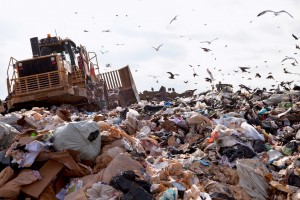 Landfills
Landfills
RCRA regulates both hazardous and non-hazardous landfills. The latter are called solid waste landfills and it is where our garbage goes. RCRA regulations cover how a landfill is built and how it is operated. In 1984, EPA started a phased “land ban” restricting certain types of wastes and liquids from being landfilled without first “rendering” them non-hazardous. RCRA also regulates how a landfill is closed and how it and nearby areas are monitored, even after closure. There are 1,900 landfills in the US. The US generates 25 Million tons/yr of RCRA hazardous waste and 250 Million tons/yr of solid waste. That's a lot of garbage. Among other requirements, today's hazardous waste landfills must have an intricate liner system and final cap and is monitored extensively to ensure it stays “tight.” Solid waste landfills also have design requirements, although they are less intricate, and a required final vented cap system to manage the methane that will be generated for decades as the garbage degrades in the ground.
With landfills, we are doing our best, but it would be better if we just generated less waste. We are making good recycling progress along those lines. Currently, 66% of paper and 8% of hazardous wastes are recycled. Most town transfer stations, which used to be dumps, are designed to separate metal, paper, and other materials for recycling.
The Real Risks
In my opinion, human health risks from landfills and hazardous waste sites are minimal. The air you breathe, the water you drink, and the water you swim in are generally safe. But there are still potential risks, such as:
- Private groundwater wells contaminated by unknown sites or releases. Not all releases or sites are well defined or even discovered yet. Check CERCLIS on the web, EPA's database of hazardous waste sites, to learn what is known in your neighborhood, and have your water tested.
- Indoor air. There are 3 threats that could cause unhealthful indoor air exposures, and considering how much time we spend in our homes, this is worth considering. It's easy to measure indoor air quality, but sometimes hard to identify the source if contamination is found. The 3 threats worth considering are:
- Radon - radon causes lung cancer and is an elemental gas often found in granite and other rocks. More than half of the country has a potential for homes to have above 2 picocuries of radon per liter air; about a third could exceed EPA's advised safe level of 4. For many homes, it is difficult to get below 1, even with remedy venting systems. But here's the rub, EPA's “safe level” is not really safe. EPA's advisory level offers a health risk greater than the trigger for cleaning up Superfund sites.
- Chemical infiltration - in my opinion, after reviewing hundreds of risk assessments at hundreds of hazardous waste sites, the most significant potential risk to neighbors is chemical infiltration to their home air by plumes of vapors in the soil pores under a home.
- Home and personal care products - I believe this is the most significant risk most people encounter every day. Think about the chemicals under your sink and the stuff you rub on your skin and hair every day. There is no question you are being exposed; the only question is if it is at levels that pose an unacceptable risk. This is totally unregulated, not even self-regulated. Go to your Supermarket's cleaning product aisle and read the labels. You will see something like 1.5% chloroparachickenwire listed along with 98.5% “inert ingredients.” Labelling laws allow the manufacturer to list any ingredient that doesn't have the claimed purpose of the product as inert, but they are not necessarily inert to your health. I once tracked down the inert ingredients in one product and found it was 50% carcinogens. EPA doesn't want to regulate the inside of your home and FDA won't regulate it if you don't eat it, but rest assured, product safety is a blind spot to be aware of. I believe the best way to deal with this is by a self-regulating product safety rating system, similar to the energy star program. Technically, there are many complex issues to such a system, but it would need to stay simple. With such a program, you could make buying decisions not just on product efficacy but also on product safety.
Well, I think I've covered enough for now, so I'll leave you with 2 conclusions:
- It took decades to get here and for good reasons. We still need improvement, but now our environment is reasonably well managed.
- Our challenge for the future is to streamline how we manage the environment - we must spend our money and time wisely - and we must address the remaining risks we face from our environment.
Bottom line, we're getting smarter and better about our environment all the time, notwithstanding climate change. But that's a story for another day.
Learn more about an environmental management degree and a career in environmental policy.
Other Lectures by Dr. Neil S. Shifrin
- Environmental Perspectives
- Environmental Management and Its History (Currently here)
- Is It Safe? Raising Environmental Questions
- Environmental Perspectives - July 30, 2018
- Environmental Management and Its History - July 31, 2015
- Is It Safe? Raising Environmental Questions - April 10, 2015
Related Articles
Featured Article

Cartography: More Than a View From Above


